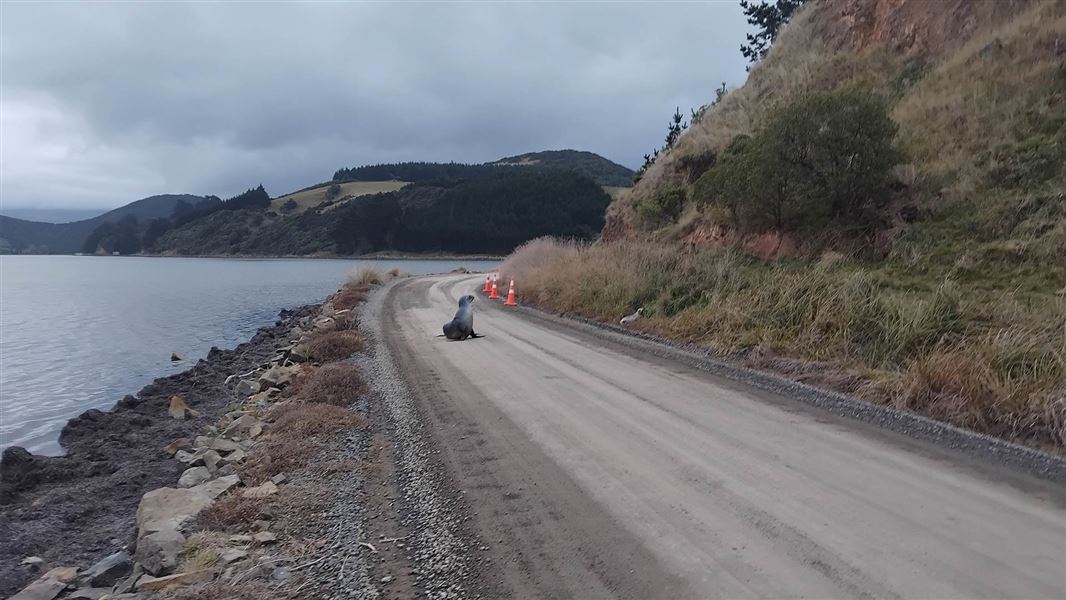Date: 05 June 2025
With fur seal and sea lion populations bouncing back around the mainland, the Department of Conservation (DOC) and Waka Kotahi NZ Transport Agency have launched a nationwide project to track where marine mammals are appearing near roads—and why.
This work builds on the success of recent guardrail installations in Kaikōura, which have already made a difference by delivering conservation gains, helping keep curious young fur seals safely off the tarmac, and reducing the risk of seal-related accidents on the road
The public is being asked to report sightings to help protect both people and wildlife as Aotearoa adapts to the return of these ocean wanderers and navigates the challenges of ‘Seal Silly Season’.
Once rare on the mainland, New Zealand fur seals and sea lions are now returning to historic habitats. Their comeback is one of Aotearoa’s conservation success stories—and brings both joy and new responsibilities.
Now, the goal is to model road-related risks for marine mammals like seals across the country – and to do that, DOC needs your help. By reporting seal sightings, you're helping create safer spaces for our native wildlife and playing a part in protecting our species.
“We’re asking people to report sightings of seals, fur seals or sea lions on or near roads,” says Jody Weir, Senior Technical Advisor – Marine. “Your sightings—date, location, even a photo if it’s safe— will help us map hotspots and understand the risks. It’s a great example of how citizen science could make a real difference.”
This national study uses existing DOC and Waka Kotahi road data and will be strengthened by public reports. The results will help inform future road planning, identify high-risk zones, and guide where further road improvements—like the motorcycle guard rail used in Kaikōura—might be needed.
The initiative is part of a growing field known as ‘road ecology’—an area of science focused on understanding how roads affect wildlife movement and behaviour. With marine mammals increasingly making their way into urban and semi-urban areas, road ecology is becoming just as valuable as the more well-known disciplines of marine and terrestrial ecology.
In Kaikōura, road ecology principles have already delivered conservation wins. Research identified key hot spots where fur seals were getting onto the SH1, leading to infrastructure upgrades that significantly reduced the risk to both animals and drivers.
The deaths of hundreds of kekeno to starvation in Kaikōura in 2023 was a sobering reminder of how vulnerable these animals can be—even with protections in place. Understanding and preventing road-related risks is one way we can reduce unnecessary harm as their populations recover.
“We’re thrilled to see populations recovering,” says Weir. “But that success comes with new challenges. We want to protect these taonga species while also keeping people safe. That means understanding where the key hot spots are and planning smarter.”
And right now, it’s also Seal Silly Season—the time of year (May to September) when young kekeno (New Zealand fur seals) venture off on their own for the first time. They're known for turning up in strange places like paddocks, stormwater drains, and yes, roads.
In previous years, fur seals have been spotted waddling down driveways, blocking footpaths, in Bunnings, in a KFC carpark and even trying to board buses. These surprise visits may seem comical, but they signal the need to plan better for human-wildlife coexistence.
“These young fur seals are out exploring their wider world while their mums are busy at sea getting food to be able to nurse that rapidly growing pup and grow the developing foetus inside her,” says Weir. “It’s an important stage of development, but it also means they can end up in unusual—and sometimes risky—places. By reporting sightings, you’re helping us look out for them during this vulnerable time.”
If you’ve had an encounter with a seal on a road or near your home (historic sighting as well)—send us your story or photo (if safe).
Seen a seal or sea lion on or near a road, let us know
Email: seeaseal@doc.govt.nz
- Include the date of your sighting, a description of the location and animal(s) (including how many), specific GPS coordinates if possible (or drop a pin), and a photo (if safe).
- Also report the same information for any dead marine mammals on or near roads.
- Reports on sections of road where you’ve previously seen marine mammals (and when) are also helpful.
- Reports submitted by 22 June 2025 will help shape the initial national road risk model—but we welcome ongoing sightings. Your input could directly influence how we design safer systems for years to come.
Seal tips
- Never touch, handle, or feed a seal, because they can be aggressive if they feel threatened. It's also a breach of the Marine Mammals Protection Act.
- Maintain a distance of at least 20 metres from kekeno if possible and avoid getting between the seal and the sea.
- Give seals space if encountered on or near a beach.
- Always keep dogs on a leash and away from seals.
- Ensure small children are at a safe distance and under control when watching seals.
- If you see a seal that's badly injured, being harassed or in danger, call 0800 DOC HOT (0800 362 468).
Contact
For media enquiries contact:
Email: media@doc.govt.nz
